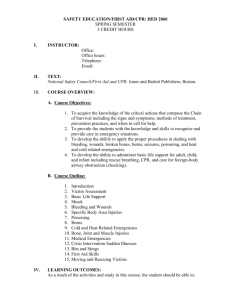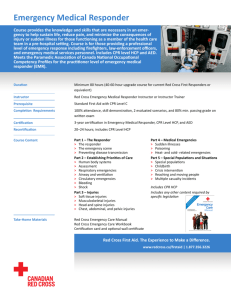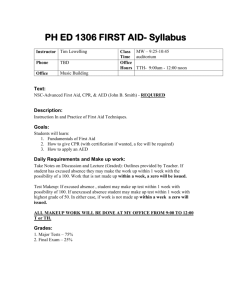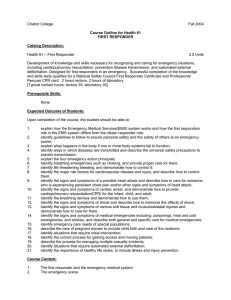Chabot College Fall 2004 – Responding to Emergencies
advertisement
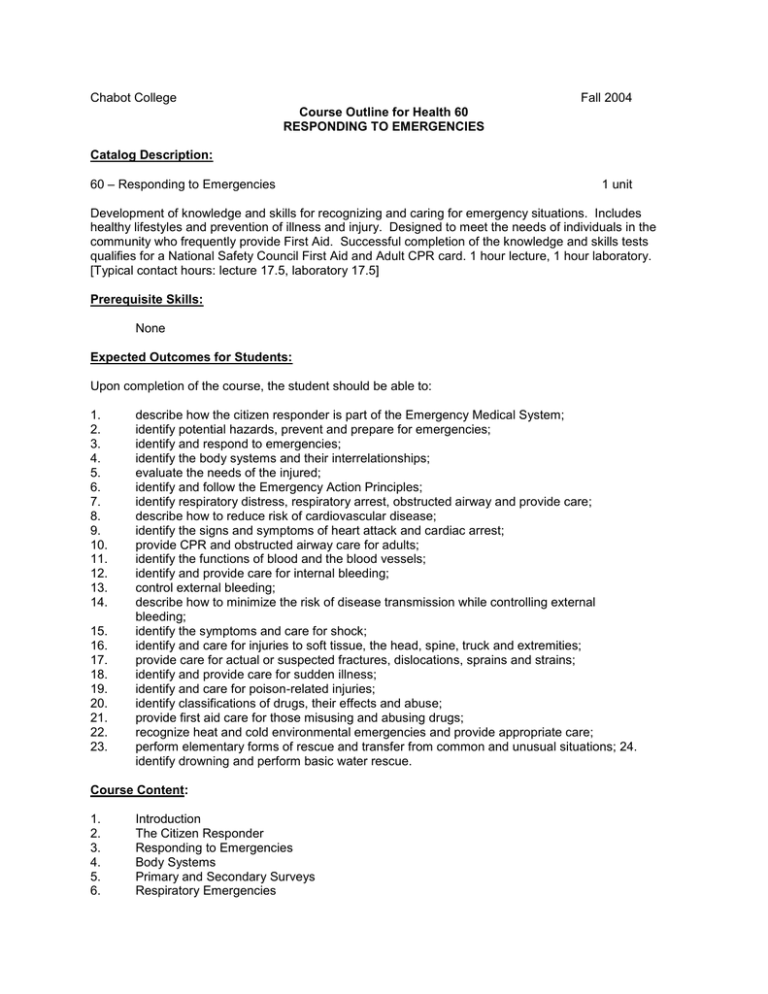
Chabot College Fall 2004 Course Outline for Health 60 RESPONDING TO EMERGENCIES Catalog Description: 60 – Responding to Emergencies 1 unit Development of knowledge and skills for recognizing and caring for emergency situations. Includes healthy lifestyles and prevention of illness and injury. Designed to meet the needs of individuals in the community who frequently provide First Aid. Successful completion of the knowledge and skills tests qualifies for a National Safety Council First Aid and Adult CPR card. 1 hour lecture, 1 hour laboratory. [Typical contact hours: lecture 17.5, laboratory 17.5] Prerequisite Skills: None Expected Outcomes for Students: Upon completion of the course, the student should be able to: 1. 2. 3. 4. 5. 6. 7. 8. 9. 10. 11. 12. 13. 14. 15. 16. 17. 18. 19. 20. 21. 22. 23. describe how the citizen responder is part of the Emergency Medical System; identify potential hazards, prevent and prepare for emergencies; identify and respond to emergencies; identify the body systems and their interrelationships; evaluate the needs of the injured; identify and follow the Emergency Action Principles; identify respiratory distress, respiratory arrest, obstructed airway and provide care; describe how to reduce risk of cardiovascular disease; identify the signs and symptoms of heart attack and cardiac arrest; provide CPR and obstructed airway care for adults; identify the functions of blood and the blood vessels; identify and provide care for internal bleeding; control external bleeding; describe how to minimize the risk of disease transmission while controlling external bleeding; identify the symptoms and care for shock; identify and care for injuries to soft tissue, the head, spine, truck and extremities; provide care for actual or suspected fractures, dislocations, sprains and strains; identify and provide care for sudden illness; identify and care for poison-related injuries; identify classifications of drugs, their effects and abuse; provide first aid care for those misusing and abusing drugs; recognize heat and cold environmental emergencies and provide appropriate care; perform elementary forms of rescue and transfer from common and unusual situations; 24. identify drowning and perform basic water rescue. Course Content: 1. 2. 3. 4. 5. 6. Introduction The Citizen Responder Responding to Emergencies Body Systems Primary and Secondary Surveys Respiratory Emergencies Chabot College Course Outline for Health 60, page 2 Fall 2004 7. 8. 9. 10. 11. 12. 13. 14. 15. 16. 17. 18. 19. 20. 21. 22. Rescue Breathing Obstructed Airways Cardiac Emergencies CPR Skills Bleeding Control Care for Shock Soft Tissue Injuries Musculoskeletal Injuries Splinting and Immobilization Specific Injuries Care Medical Emergencies Substance Abuse and Misuse Heat and Cold Environmental Emergencies Rescue and Transfer Moves Drowning and Basic Water Rescue Healthy Lifestyles Methods of Presentation: 1. 2. 3. 4. Lecture Discussions Demonstration/Practice Audio-Visual Typical Assignments and Methods of Evaluating Student Progress: 1. Typical Assignments a. Splint a leg fracture b. Control bleeding from an arterial injury 2. Evaluation of Student Progress a. Written mid-term and final examination b. Performance of Skills Tests Textbook(s) (typical): National Safety Council “First Aid/CPR”, 3rd edition, Alton Thygerson, Jones & Bartlett Publishers, 2002 Special Student Materials: 1. 2. CPR manikin face mask Pocket mask BP:al Revised: 10/15/03
